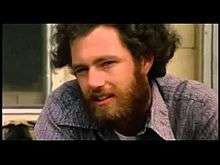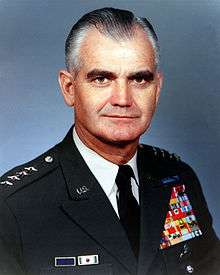Hearts and Minds (film)
| Hearts and Minds | |
|---|---|
 Criterion Collection DVD Cover | |
| Directed by | Peter Davis |
| Produced by |
Bert Schneider Peter Davis |
Production company | |
| Distributed by |
Rainbow Releasing Warner Bros. |
Release dates | 1974 |
Running time | 112 minutes |
| Country | United States |
| Language | English |
| Budget | $1 million |
Hearts and Minds is a 1974 American documentary film about the Vietnam War directed by Peter Davis. The film's title is based on a quote from President Lyndon B. Johnson: "the ultimate victory will depend on the hearts and minds of the people who actually live out there".[1] The movie was chosen as Academy Award for Best Documentary Feature at the 47th Academy Awards presented in 1975.[2]
The film premiered at the 1974 Cannes Film Festival. Commercial distribution was delayed in the United States due to legal issues, including a temporary restraining order obtained by one of the interviewees, former National Security Advisor Walt Rostow who had claimed through his attorney that the film was "somewhat misleading" and "not representative" and that he had not been given the opportunity to approve the results of his interview.[3] Columbia Pictures refused to distribute the picture, which forced the producers to purchase back the rights and release it by other means. The film was shown in Los Angeles for the one week it needed to be eligible for consideration in the 1974 Academy Awards.
Featured individuals
A scene described as one of the film's "most shocking and controversial sequences" shows the funeral of an ARVN soldier and his grieving family, as a sobbing woman is restrained from climbing into the grave after the coffin.[4] The funeral scene is juxtaposed with an interview with General William Westmoreland — commander of American military operations in the Vietnam War at its peak from 1964 to 1968 and United States Army Chief of Staff from 1968 to 1972 — telling a stunned Davis that "The Oriental doesn't put the same high price on life as does a Westerner. Life is plentiful. Life is cheap in the Orient." After an initial take, Westmoreland indicated that he had expressed himself inaccurately. After a second take ran out of film, the section was reshot for a third time, and it was the third take that was included in the film.[5][6] Davis later reflected on this interview stating, "As horrified as I was when General Westmoreland said, 'The Oriental doesn’t put the same value on life,' instead of arguing with him, I just wanted to draw him out... I wanted the subjects to be the focus, not me as filmmaker."[7]
The film also includes clips of George Thomas Coker, a United States Navy aviator held by the North Vietnamese as a prisoner of war for 6½ years, including more than two years spent in solitary confinement.[8] One of the film's earliest scenes details a homecoming parade in Coker's honor in his hometown of Linden, New Jersey, where he tells the assembled crowd on the steps of city hall that if the need arose, that they must be ready to send him back to war.[9] Answering a student's question about Vietnam at a school assembly, Coker responds that "If it wasn't [sic] for the people, it was very pretty. The people there are very backwards and primitive and they make mess out of everything."[6][10][11] In a 2004 article on the film, Desson Thomson of The Washington Post comments on the inclusion of Coker in the film, noting that "When he does use people from the pro-war side, Davis chooses carefully."[6] Time magazine's Stefan Kanfer noted the lack of balance in Coker's portrayal, "An ex-P.O.W.'s return to New Jersey is played against a background of red-white-and-blue-blooded patriots and wide-eyed schoolchildren. The camera, which amply records the agonies of South Vietnamese political prisoners, seems uninterested in the American lieutenant's experience of humiliation and torture."[12]
The film also features Vietnam war veteran and anti-war activist Bobby Muller, who later founded the Vietnam Veterans of America.[6][13]
Daniel Ellsberg, who had released the Pentagon Papers in 1971, discusses his initial gung-ho attitude toward the war in Vietnam.[14]

The concluding interview features US Vietnam veteran Randy Floyd, stating "We've all tried very hard to escape what we have learned in Vietnam. I think Americans have worked extremely hard not to see the criminality that their officials and their policy makers exhibited."[15]
The film includes images of Phan Thị Kim Phúc in sections of a film shot of the aftermath of a napalm attack which shows Phúc at about age nine running naked on the street after being severely burned on her back.[6]
List of Interviewees
The following list excludes second appearances, and people who are uncredited: the latter include various presidents (Nixon, Kennedy, Johnson etc) and Bob Hope:
|
|
Critical reception
Hearts and Minds has attracted widely polarized opinions from film critics since its release. Reviewers commonly regard it either as a masterpiece of political/documentary filmmaking or a propagandistic hatchet job on the Vietnam War, with some viewing it as both.[16][17] A mixture of mostly contemporary film critic reviews on the review tallying website Rotten Tomatoes reports that 93% of the 30 film critics reviews they tallied were positive with an average critics score of 8.2 out of 10.[18]
Vietnam War films from the 1960s to the 1970s reflected deep divisions at home over the war. Some reflected pro-war sentiments and vilified anti-war protesters, while others stood at the opposite end and criticized government officials and policies. "Hearts and Minds" was one of the first of the latter to have been produced and released before the war's end in 1975.[19]
Vincent Canby of The New York Times called it an "epic documentary ... [that] recalls this nation's agonizing involvement in Vietnam, something you may think you know all about, including the ending. But you don't."[14] Canby included the film among his ten best of 1975, calling it a "fine, complex, admittedly biased meditation upon American power" and a movie "that will reveal itself as one of the most all-emcompassing records of the American civilization ever put into one film."[20] Desson Thomson of The Washington Post described it as "one of the best documentaries ever made, a superb film about the thoughts and feelings of the era, the whole festering, spirited animus of it."[6] Rex Reed called it that year's "best film at the Cannes Film Festival" and stated that "[t]his is the only film I have ever seen that sweeps away the gauze surrounding Vietnam and tells the truth."[21] World Movies, the Australian subscription TV channel, included Hearts and Minds in its 2007 series of 25 Docs You Must See Before You Die.[22]
Other reviewers have criticized the movie for its biased presentation. Roger Ebert for the Chicago Sun Times wrote: "Here is a documentary about Vietnam that doesn't really level with us ... If we know something about how footage is obtained and how editing can make points, it sometimes looks like propaganda ... And yet, in scene after scene, the raw material itself is so devastating that it brushes the tricks aside."[23] Walter Goodman of The New York Times in an article titled False Art of the Propaganda Film, pointed out Davis' technique of showing only one side of the interview, pointing out that Walt Rostow's response may have been in response to "some provocation, a gesture, a facial expression, a turn of phrase" from his interrogator.[24] To this criticism, actress Shirley MacLaine responded, "[Mr. Goodman] displays the very deception and distortion that is usually associated with the pejorative meaning of propaganda. For example, Mr. Goodman starts out by claiming that in most countries, propaganda is a monopoly of the state, but that in the United States the most notable examples of propaganda 'come from the state's adversaries.' This is ridiculous. In America, the state spends millions of dollars every year on propaganda."[25]
David Dugas of United Press International, in a 1975 review printed in Pacific Stars and Stripes, saw that "Davis' approach clearly is one-sided and is not likely to impress Vietnam hawks. But his film is brilliantly assembled, biting and informative."[3]
Colin Jacobson wrote in his review of the movie for the DVD Movie Guide: "Probably the biggest criticism one can level at [Hearts and Minds] stems from its editorial bent. Without question, it takes the anti-war side of things, and one could argue it goes for a pro-Vietnamese bent as well....In the end, Hearts and Minds remains a flawed film that simply seems too one-sided for its own good."[26] In his review, David Ng of the online Images: A Journal of Film and Popular Culture wrote: "The documentary is clearly anti-war in both tone and content."[27] M. Joseph Sobran, Jr. of the conservative magazine National Review, wrote: "... blatant piece of propaganda ... disingenuously one-sided ..." and goes on to show the cinematic techniques used by the producers to achieve this effect.[28] Stefan Kanfer of Time magazine notes that "Throughout, Hearts and Minds displays more than enough heart. It is mind that is missing. Perhaps the deepest flaw lies in the method: the Viet Nam War is too convoluted, too devious to be examined in a style of compilation without comment."[12]
Michael Moore has cited Hearts and Minds as the one film that inspired him to become a filmmaker, calling it "not only the best documentary I have ever seen...it may be the best movie ever".[1][29] Many of the cinematic techniques used in Hearts and Minds are similar to Moore's 2004 documentary Fahrenheit 9/11.[16]
Academy Award
After Columbia Pictures refused to distribute the picture, the producers Bert Schneider and Henry Jaglom purchased back the rights and released the film in March 1975 through Warner Bros. A planned December 18, 1974 opening in Los Angeles, California was canceled after the production company had been unable to pay the $1 million needed to buy the rights from Columbia Pictures. The film was ultimately shown in Los Angeles for the one week it needed to be eligible for consideration in the 1974 Academy Awards.[30]
During his acceptance of the Academy Award ceremonies on April 8, 1975, co-producer Bert Schneider said, "It's ironic that we're here at a time just before Vietnam is about to be liberated" and then read a telegram containing "Greetings of Friendship to all American People" from Ambassador Dinh Ba Thi of the Provisional Revolutionary Government (Viet Cong)[31] delegation to the Paris Peace Accords.[32] The telegram thanked the anti-war movement "for all they have done on behalf of peace".[19] Frank Sinatra responded later by reading a letter from Bob Hope, another presenter on the show, "The academy is saying, 'We are not responsible for any political references made on the program, and we are sorry they had to take place this evening.'"[33]
Preservation
The Academy Film Archive preserved Hearts and Minds in 2000.[34]
See also
References
- 1 2 Schwartz, Larry. "Inside the body of a war zone", The Age, September 13, 2007. Accessed August 11, 2008.
- ↑ "NY Times: Hearts and Minds". NY Times. Retrieved 2008-11-15.
- 1 2 Dugas, David via United Press International. "Viet War Film Late, Or Maybe Just in Time", Pacific Stars and Stripes via Newspaper Archive, February 25, 1975. Accessed August 15, 2008.
- ↑ Dittmar, Linda; and Michaud, Gene. From Hanoi to Hollywood: The Vietnam War in American Film, Rutgers University Press, 1990 via Google Books, p. 273. ISBN 0-8135-1587-4.
- ↑ Jackson, Derrick Z. (July 22, 2005). "Derrick Z. Jackson: The Westmoreland mind-set". International Herald Tribune. Retrieved January 26, 2008.
- 1 2 3 4 5 6 Desson Thomson (October 22, 2004). "'Hearts And Minds' Recaptured". The Washington Post. Retrieved 2007-12-23.
- ↑ Katz, Sarah (January 2008). "An Interview With Peter Davis". Center for Social Media. Archived from the original on 2008-03-02. Retrieved 2010-04-03.
- ↑ Return With Honor Transcript, PBS. Accessed August 11, 2008.
- ↑ Anderegg, Michael A. (1991). Inventing Vietnam: The War in Film and Television. Temple University Press. ISBN 978-0-87722-862-2. Retrieved 2008-01-10.
- ↑ Lane, Anthony (2004-11-01). "Aftermaths: Enduring Love, Hearts and Minds". The New Yorker. Retrieved 2008-07-29.
- ↑ "Terror and trauma.". London: The Guardian. November 18, 2005. Retrieved 2008-01-27.
- 1 2 Kanfer, Stefan. "War-Torn', Time (magazine),March 17, 1975. Accessed August 11, 2008.
- ↑ "Scores of Reasons to See These Silent Films", The Washington Post, October 15, 2004. Accessed August 6, 2008.
- 1 2 Canby, Vincent. "'Hearts and Minds,' a Film Study of Power", The New York Times, March 24, 1975. Accessed August 6, 2008.
- ↑ Monaco, James. (Summer 2003). "Hearts & Minds". Cineaste (magazine). Retrieved November 15, 2008.
- 1 2 Wilder, Carol (2005). "Separated at Birth: Argument by Irony in Hearts and Minds and Fahrenheit 9/11". Atlantic Journal of Communication. The New School (Summer 2005). Retrieved 2008-06-25.
What can the striking similarities and differences of these pictures tell us about the media environments of their respective times? What do they reveal about the architecture of cinematic argument? About the eternal verities of war rhetoric?
- ↑ O'Callaghan, Paul (March 11, 2015). "10 great Vietnam War films". British Film Institute. Retrieved August 31, 2016.
- ↑ http://www.rottentomatoes.com/m/hearts_and_minds/
- 1 2 Schulzinger, Robert D., "A Time for Peace: The Legacy of the Vietnam War", page 155, Oxford University Press, Oxford & New York, 2006
- ↑ Canby, Vincent. "FILM VIEW; The Ten Best Films of 1975", The New York Times, December 28, 1975. Accessed August 14, 2008.
- ↑ Reed, Rex. "A film Americans nay not see", Independent Press-Telegram, via Newspaper Archive, August 18, 1974. Accessed August 15, 2008.
- ↑ "25 Docs You Must See Before You Die". World Movies. Retrieved January 27, 2008.
- ↑ "Hearts and Minds". Chicago Sun Times. January 1, 1974. Retrieved 2008-08-11.
- ↑ Goodman, Walter. "The False Art of the Propaganda Film", The New York Times, March 23, 1975. Accessed August 14, 2008.
- ↑ MacLaine, Shirley. (April 6, 1975). "'Propaganda' is What You Don't Agree With". The New York Times. Retrieved November 15, 2008.
- ↑ Jacobson, Colin (1974). "Hearts and Minds: Criterion (1974)". DVD Movie Guide. Retrieved 2008-06-24.
- ↑ Ng, David. (2002). "Images: A Journal of Film and Popular Culture". Retrieved 2007-12-22.
- ↑ Sobran Jr., M. J. (1975-06-06). "Heartless and Mindless". National Review. via EBSCO. 27 (21): 621. ISSN 0028-0038. Retrieved 2008-06-24.
- ↑ Kennedy, Lisa. "``Hearts and Minds run has new appeal", Denver Post, November 9, 2004. Accessed August 11, 2008.
- ↑ "Documentary on Vietnam Fails to Open; 'Somewhat Misleading", The New York Times, December 19, 1974. Accessed August 11, 2008.
- ↑ Biskind, Easy Riders, Raging Bulls, p. 275.
- ↑ Robinson, George. Sometimes A Thank You Isn't Enough", The New York Times, March 4, 2001. Accessed May 29, 2008.
- ↑ Efron, Eric. " The World: Acting Out; At the Oscars, a Cause and Effect", The New York Times, March 30, 2003. Accessed May 29, 2008.
- ↑ "Preserved Projects". Academy Film Archive.
- Peter Biskind. Easy Riders, Raging Bulls: How the Sex-Drugs-and Rock 'N Roll Generation Saved Hollywood, New York: Simon and Schuster, 1998. pp. 178ff., plate x.
External links
- Hearts and Minds at the Internet Movie Database
- Hearts and Minds at AllMovie
- Hearts and Minds Judith Crist essay at Criterion Collection
- Hearts and Minds George Herring essay at Criterion Collection
- Hearts and Minds Ngo Vinh Long essay at Criterion Collection
- Hearts and Minds Robert K. Brigham essay at Criterion Collection
- Hearts and Minds film trailer on YouTube
- "Hearts and Minds Collection, 1970-1974", University Archives & Special Collections

